How to water an orchid?

The orchid is a finicky flower that requires careful maintenance. In order for a plant to please the eye with its attractiveness, it should be provided with the correct temperature regime, regular feeding, and the proper level of lighting. But the most important nuance of caring for a flower is its watering, so you should carefully study the recommendations on how to properly water an orchid.
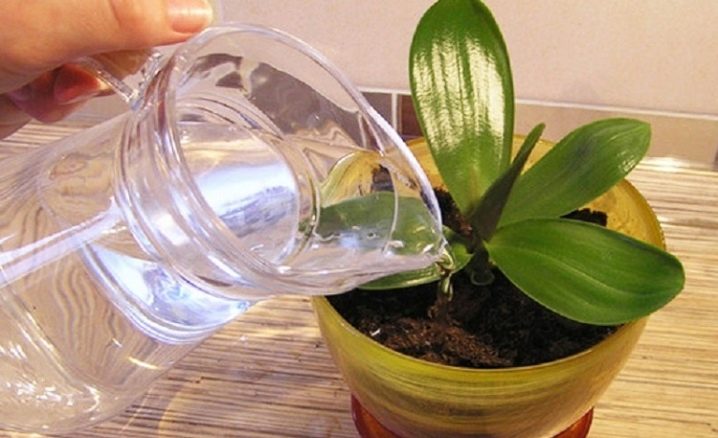
How often to water the orchid?
The frequency of irrigation must be determined depending on the conditions in which the flower is kept. The following factors affect the frequency of humidification:
- seasonality;
- life cycle;
- humidity coefficient in the room;
- room temperature;
- the soil used and the type of pot.
To understand that a plant needs moisture, you need to do the following.
- Examine the pot. The presence of condensation drops on the walls indicates that there is no need for humidification. If the surface is dry, then water the orchid.
- Examine the root system. If the color of the roots is green, then the flower has a sufficient amount of moisture. In cases where root clarification is observed, watering will be required.
- Measure the mass. The wetted plant is heavy. If the flower pot has become light, then the orchid needs moisture.
- Check the soil with a stick.
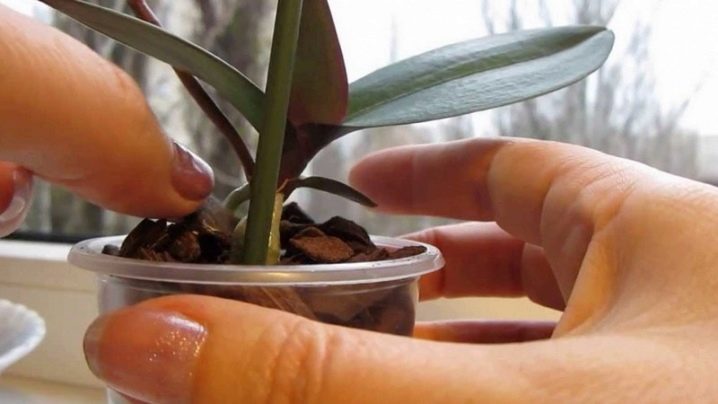
In the hot period, the substrate should be moistened 1-3 times a week. Different types of plants require different amounts of water and at different intervals. During the dormant period, it is enough to water the plant 1-2 times a month. When providing home care, it is important not only to regularly moisten the soil, but also to choose the appropriate time for the procedure.
It is best to do this during the daytime so that there is no condensation on the plant until the evening.
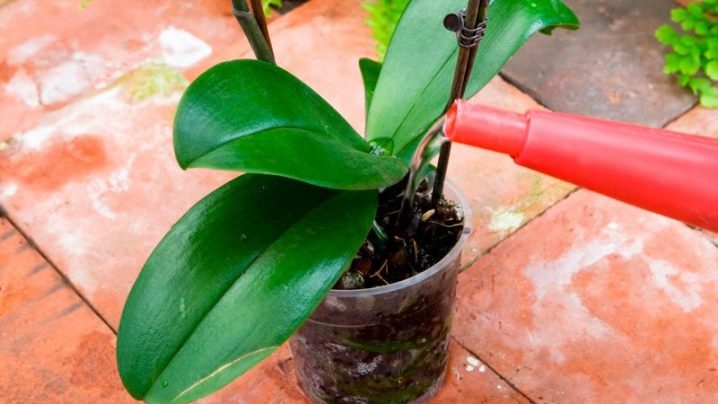
Watering methods
There are several ways to water your orchid. Choose a method depending on the option of growing a flower. Regardless of the method chosen, you must properly prepare the water. A walkthrough looks something like this:
- it is best to moisten the soil with rainwater;
- in the absence of such an opportunity, use boiled;
- to remove impurities, salts, iron compounds, chlorine, water should be passed through a filter, having previously allowed it to settle;
- you can add oxalic acid to the container before watering, which will help soften the water, and peat will also help to do this.
It is strictly forbidden to use tap water. This can seriously harm the health of the plant. The temperature of the water is also considered an important point. It should be roomy.
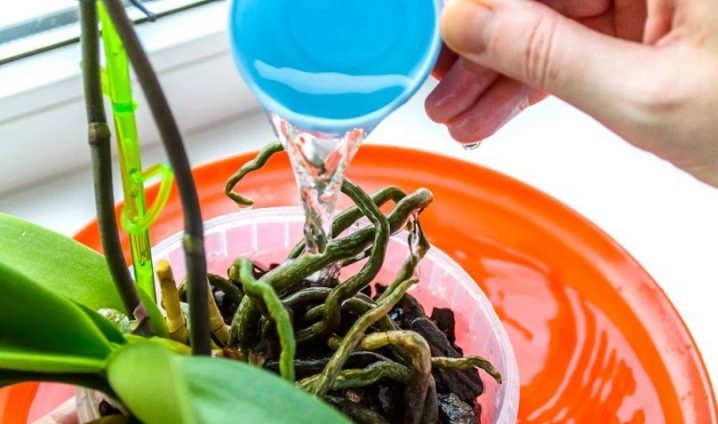
Hot shower
This method helps to ensure quality flowering and an increase in green mass. The variant resembles the humidification that occurs in the natural environment, so the orchid "likes" it very much. Irrigation from the top also provides an opportunity to thoroughly clean the leaves, prevent pests and disease infestation.
It is recommended to water the flower with 38 ° C water. In rare situations, it is allowed to take a hotter one - 40-50 ° C. This method involves the use of running water, but only in cases where such irrigation is rarely performed. The hot shower method is as follows:
- the plant with the pots is placed in the bath;
- turn on the shower with a light pressure and irrigate the orchid from above;
- the duration of the procedure will depend on the type of soil; watering is finished when the plant is completely saturated with moisture;
- after a shower, the plant is left for 30 minutes so that the water glass, since remaining in the pan, it can cause waterlogging and rotting of the root processes;
- the final step will be wiping the leaves to eliminate moisture stagnation in the sinuses.
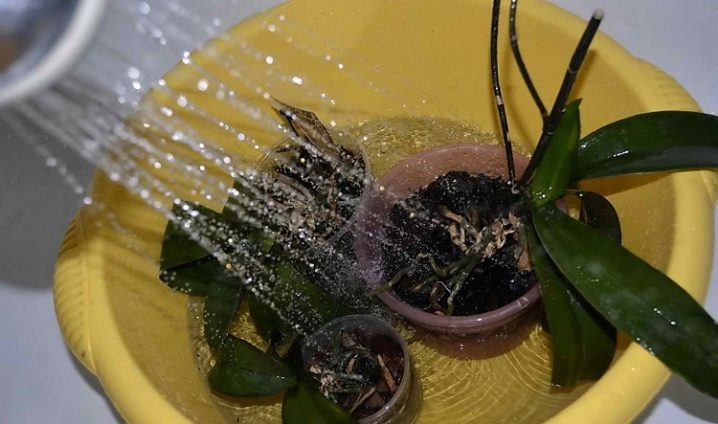
If the water is too hard, then it is better to give up the shower, as accumulations of salts may remain on the leaves. This is an undesirable phenomenon for flowers. To get rid of salt stains, it is recommended to use a citric acid solution that neutralizes the effect of salts.
In order not to harm the plant, you should keep it in the bathroom for about 30 minutes, insofar as a sharp change in temperature can lead to freezing of the orchid. This irrigation method requires strict control.
Those who cannot devote much time to caring for an orchid are more likely to choose the wick irrigation method, which requires minimal human intervention.
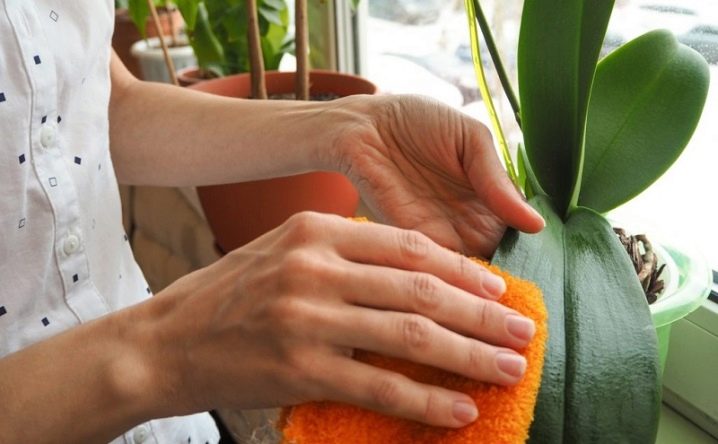
Immersion
This option is suitable not only for saturation with moisture, but also for fertilization, if you first dilute the additives in water. The method implies immersing the plant in a container filled with water. In this case, the edge the planter must be above the water level. The duration of the immersion depends on the size of the pot, as well as the development of the root system, while the time should not exceed 15 minutes. During this period, the roots will have time to be saturated with moisture.
After the end of the immersion, the orchid must be allowed to drain. Excess moisture is removed. This watering method is considered the most economical and safest, since the stem and leaves do not get wet. To carry out such a procedure, it is worth making sure that the plant is absolutely healthy, since this method is unacceptable for sick and affected orchids.
In some situations, several pots of orchids are lowered into a common basin. This must be done with caution, since if there is at least one diseased plant, there is a high risk of infecting the rest.
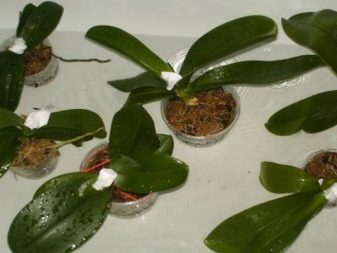

Leica
This method involves the use of a long-nosed watering can. In this way, it will be possible to ensure uniform watering without damaging the leaves and stems. The plant should be irrigated with a moderate stream until water flows out of the drain holes. Need to do 2-3 passes, after each remove excess water from the sump.
This method of watering has a significant plus - it excludes moisture from entering the sinuses, which prevents the process of stem and leaf rotting. To achieve maximum effect without harming the orchid, watering should be carried out in the early morning. This will allow moisture to be absorbed evenly throughout the day, and in the evening the plant will be able to "rest".
Watering with a watering can also helps to get rid of bacteria and fungi that accumulate in the substrate. To do this, prepare a weak solution of potassium permanganate.

Root spraying
This option is relevant when growing plants on blocks, without a substrate. For potted plants, you can also use this method, but it must be combined with another, which will provide a greater saturation of the roots with moisture. For root spraying, you will need a spray bottle. Irrigation must be carried out through a fine dropper in the "fog" mode.
This must be done until the roots turn green. With such watering, plant organs are safe, overflow is excluded. Among the disadvantages of this method are the need for daily irrigation. This is due to the fact that the roots dry quickly without a substrate.
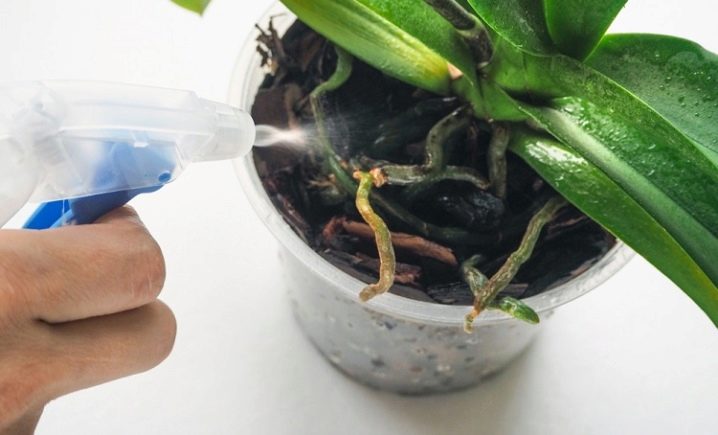
We take into account the nuances
Observing general recommendations, you can achieve the longevity of the orchid and its abundant growth and flowering at home. For example, spraying with water with hydrogen peroxide stimulates the growth of green mass, accelerates the flowering process, eliminates diseasesand also prevents them. But there are certain situations in which you need to apply an individual approach to the irrigation process.
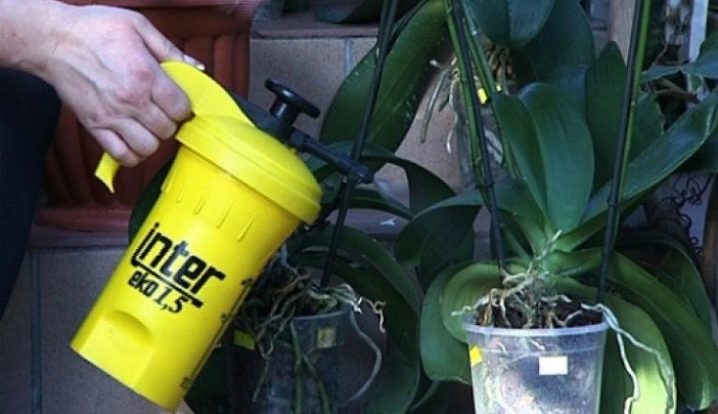
Watering during flowering
A blooming orchid requires more moisture than when it is dormant. That is why during such a period it is not necessary to wait until the substrate is completely dry. When completely dry, a change in the color of the leaves can be observed, the flower becomes lethargic and lifeless, which negatively affects the bud. The plant should be irrigated several times a week. It is better if only the roots are in contact with moisture. Watering with a long-nosed watering can or root spraying is ideal.
If the air in the room where the plant is located is too dry, then you can spray the leaves, but make sure that water does not fall directly on the flower.
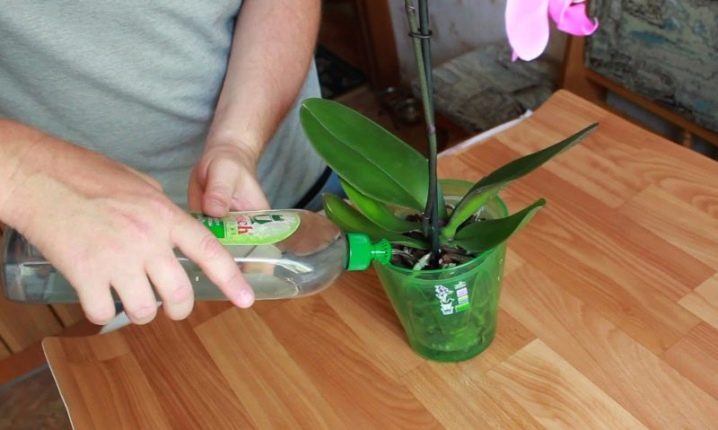
In winter
In winter, the moisture requirement of an orchid is significantly lower than in other seasons. It is enough to water the plant about once every 2 weeks. The main thing is to monitor the drying of the roots.
Winter care should include temperature control. This is due to the fact that at temperatures below 18 ° C, the root system begins to absorb less moisture. To avoid freezing the roots, you can use foam coasters or special rugs.
Watering the plant also needs to be done carefully. After saturation of the roots with moisture, it is worth leaving the pot alone so that the excess water glass. This will prevent the plant from freezing when moving to a cooler windowsill (where flowers usually stand).
If the warm shower method is used for watering, then it is better to spend it in the evening, and leave the orchid in the bathroom at night. This will create comfortable conditions for soaking the substrate and exclude the formation of rot.
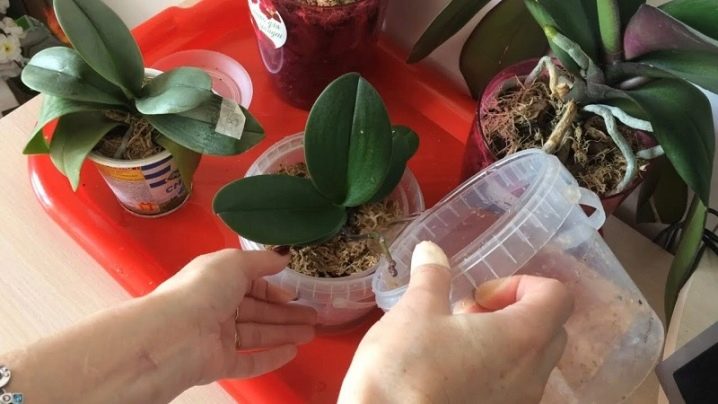
After the purchase
Watering after purchasing an orchid depends on the condition of the plant. First of all, it is worth assessing the condition of the root system. Often in a flower pot there is peat cupwhich helps to retain moisture at the base of the roots. It should be removed to avoid water stagnation and decay. When removing the cup, it is also necessary to remove rotten and dried roots, if any.
The purchased orchid should be isolated from other plants, and also slightly limited direct sun exposure to the flower. It is also not recommended to immediately feed. Temporary quarantine will allow you to determine the presence of diseases and get rid of pests in time. At the time of isolation, it is better to limit the plant in watering. But this only applies to dormant orchids.
If the plant to be purchased is in bloom, then it cannot be limited to watering. In such cases, the flower pot should be placed in a bright, warm room and provided with moderate irrigation until the roots have acquired the desired color. The most effective method of watering after purchase is immersion. It allows not only to saturate the plant with moisture, but also to wash out unwanted impurities from the substrate.
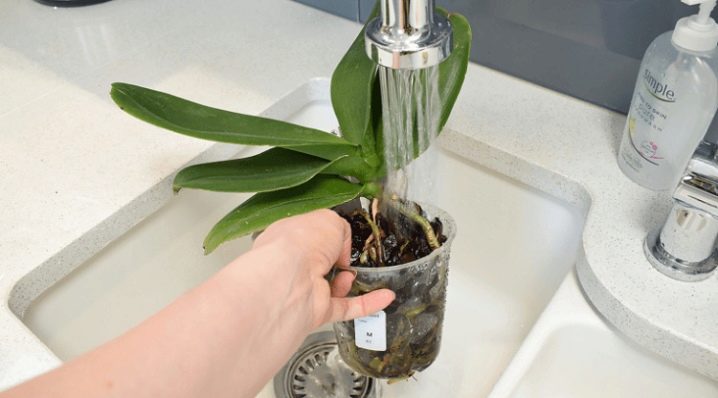
After transplant
The plant is transplanted most often immediately after acquisition or in the spring, when the flower comes out of hibernation. In addition to transplanting, the orchid may require root pruning and fertilizing. The substrate for the procedure is bought ready-made in a store or made by hand at home. In any case, it is very dry, which makes it possible to exclude the development of fungus. That's why Immediately after planting, it is important to saturate the soil with moisture.
The immersion method is often used to water the transplanted orchid. The pot is immersed in warm water for 20 minutes. After the roots are saturated with water, excess moisture must be allowed to drain. After the procedure, the plant must be placed in a darkened place, since transplants are very stressful for the flower. The next irrigation must be done not earlier than after 2 weeks.
At the end of the adaptation process of the orchid watering should be brought up to 2-3 times a week. This applies to those cases when the transplant falls in the summer period and the moment of flowering.
Water must be used exclusively purely, and additional fertilizing will be required to accelerate the restoration of the balance of nutrients in the organs of the plant.

Errors
Orchid care must be carried out strictly according to the rules, since violations can be fatal to the flower. You need to monitor not only watering, but also the lighting, as well as the state of the air. When growing, it is better to adhere to the principle of cyclicity, as this helps to create the conditions for keeping the plant as close to natural conditions as possible.
Most often, novice amateurs make mistakes when caring for such a capricious flower. However, even experienced flower growers can make minor inaccuracies that will affect the condition, growth and flowering of an orchid.
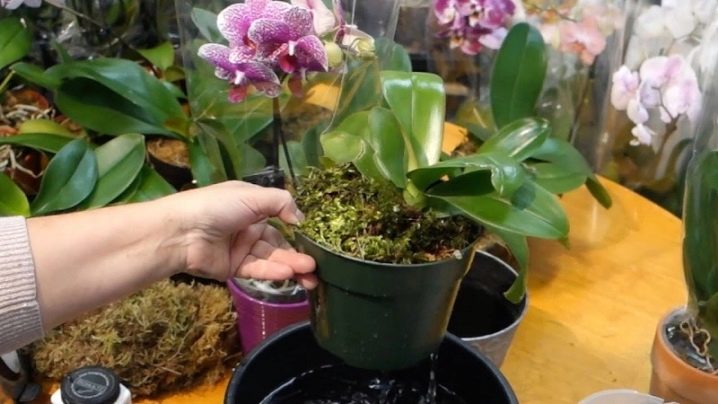
In order not to harm the flower, the following mistakes should be avoided.
- Overflowing. It is very easy to fill the plant. Untimely, frequent or excessively abundant watering will lead to stagnation of moisture and decay of the root system. To prevent this, it is recommended to use a foam drain. A four centimeter layer will prevent overflow. It is not recommended to make a pillow of expanded clay or gravel, as it will become an ideal breeding ground for pests.
- Filling the axils of the leaves. With shallow watering, care must be taken to ensure that no water remains in the sinuses. This will lead to decay and further death of the flower.
- Spraying too close. It is necessary to irrigate the plant in this way from a distance of at least 20 cm. In this case, spraying should be carried out in a gentle mode. If this rule is not observed, defects on the leaves in the form of small dents or a change in their color, deterioration of appearance are possible.
- Irrigation with poor quality water. The presence of impurities, increased hardness, improper temperature can lead to salt deposition, yellowing of leaves and death of the root system.
- Wrong time to spray. Such care is irrelevant in the winter, since the leaves can freeze due to temperature differences and become an excellent breeding ground for pathogens. Irrigation is also contraindicated in cases where the orchid has been exposed to direct sun for a long time. In these situations, there is a great risk of burns.
- Night watering. The best time to irrigate is in the morning. Then the orchid will have time to dry out in a day. Watering the plant in the evening is possible in exceptional cases.
- When using the immersion method it is important to change the water after each plant. This will eliminate the risk of infection if one of the flowers is already sick.
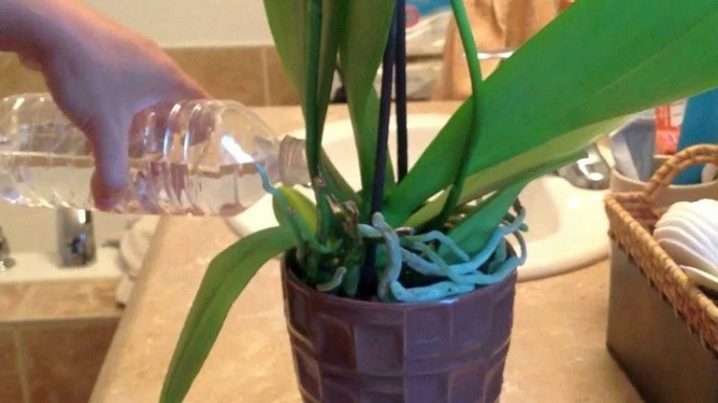
When caring for a tropical plant, it is important to keep track of its needs. It is necessary to observe the behavior of the orchid, to understand its "desires". If there is no flowering, growth has slowed down, or negative changes in appearance are observed, it is worth changing the exit strategy. Following the recommendations of experts, it will be possible to achieve an ideal result and get a plant that will delight with regular flowering and lush greenery.

You can find out the subtleties and secrets of watering an orchid by watching the video below.































The comment was sent successfully.